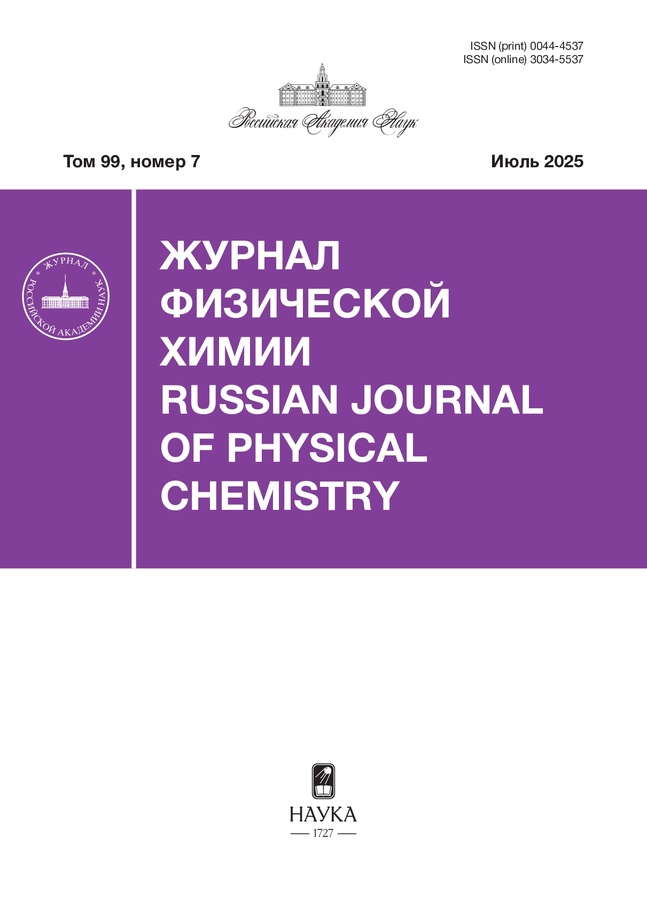Сравнение каталитических свойств Pt- и Co-катодов в реакции восстановления нитритов до аммиака
- Авторы: Кузнецова И.И.1, Лебедева О.К.1, Культин Д.Ю.1, Кустов Л.М.1,2
-
Учреждения:
- Московский государственный университет им. М. В. Ломоносова
- Институт органической химии им. Н. Д. Зелинского Российской академии наук
- Выпуск: Том 99, № 2 (2025)
- Страницы: 331-338
- Раздел: ЭЛЕКТРОХИМИЯ. ГЕНЕРАЦИЯ И АККУМУЛИРОВАНИЕ ЭНЕРГИИ ИЗ ВОЗОБНОВЛЯЕМЫХ ИСТОЧНИКОВ
- Статья получена: 19.06.2025
- Статья опубликована: 20.05.2025
- URL: https://jdigitaldiagnostics.com/0044-4537/article/view/685284
- DOI: https://doi.org/10.31857/S0044453725020205
- EDN: https://elibrary.ru/DCWCKT
- ID: 685284
Цитировать
Полный текст
Аннотация
Исследована электрохимическая реакция восстановления нитритов (NO2–RR) в нейтральном водном электролите, имеющая важное применение, как для будущих процессов синтеза аммиака, так и для эффективной очистки сточных и сельскохозяйственных сбросов. Проведено сравнение каталитической активности (получены результаты выхода по току (Фарадеевской эффективности) и скорости образования аммиака) для благородного (платина) и неблагородного (кобальт) металлов. Электродами-катализаторами служили металлические поликристаллические платина и кобальт. Поверхность катализаторов была проанализирована при помощи сканирующей и оптической микроскопии. Метод потенциодинамических кривых служил для предварительного выявления потенциала синтеза аммиака и оценки плотности тока синтеза. Были получены значения выхода по току (Фарадеевская эффективность, FE) и скорость образования аммиака при выбранных пяти значениях плотностей тока. Было обнаружено, что более эффективным является кобальтовый катод (FE ≈ 99%, скорость образования (NH3) = 2.4 мкмоль ч–1 см–2), что превышает значения для платинового катода (FE = 88.1%, скорость образования (NH3) = 0.4 мкмоль ч–1 см–2). Была определена электрохимически активная поверхность рабочих электродов-катализаторов. Объяснение такой активности катализаторов дано согласно результатам работы, которые демонстрируют, что катод из неблагородного металла может быть более эффективным для NO2–RR, чем платиновый катод.
Полный текст
Об авторах
И. И. Кузнецова
Московский государственный университет им. М. В. Ломоносова
Email: lmkustov@mail.ru
Химический факультет
Россия, 119991, МоскваО. К. Лебедева
Московский государственный университет им. М. В. Ломоносова
Email: lmkustov@mail.ru
Химический факультет
Россия, 119991, МоскваД. Ю. Культин
Московский государственный университет им. М. В. Ломоносова
Email: lmkustov@mail.ru
Химический факультет
Россия, 119991, МоскваЛ. М. Кустов
Московский государственный университет им. М. В. Ломоносова; Институт органической химии им. Н. Д. Зелинского Российской академии наук
Автор, ответственный за переписку.
Email: lmkustov@mail.ru
Московский государственный университет им. М. В. Ломоносова, Химический факультет
Россия, 119991, Москва; 119991, МоскваСписок литературы
- Makepeace J.W., He T., Weidenthaler C. et al. // Int. J. Hydrogen Energy. 2019. V. 44. P. 7746. https://doi.org/10.1016/j.ijhydene.2019.01.144
- John J., MacFarlane D.R., Simonov A.N. // Nat. Catal. 2023. V. 6. P. 1125. https://doi.org/10.1038/s41929-023-01060-w
- Lebedeva O., Kultin D., Каlenchuk A., Кustov L. // Curr. Opin. Electrochem. 2023. V. 38. P. 101207. https://doi.org/10.1016/j.coelec.2022.101207
- Imamura K., Kubota J. // Sustainable Energy Fuels. 2019. V. 3. Р. 1406. https://doi.org/10.1039/C9SE00049F.
- Shao J., Jing H., Wei P. et al. // Nat. Energy. 2023. V. 8. Р. 1273. https://doi.org/10.1038/s41560-023-01386-6
- Murphy E., Liu Y., Matanovic I. et al. // Nat. Commun. 2023. V. 14. Р. 4554. https://doi.org/10.1038/s41467-023-40174-4
- Bai L., Franco F., Timoshenko J. et al. // J. Am. Chem. Soc. 2024. V. 146. Р. 9665. https://doi.org/10.1021/jacs.3c13288
- Jiang Z., Wang Y., Lin Z. et al. // Energy Environ. Sci. 2023. V. 16. Р. 2239. https://doi.org/10.1039/D2EE03502B
- Kuznetsova I., Lebedeva O., Kultin D. et al. // Int. J. Mol. Sci. 2024. V. 25. Р. 7089. https://doi.org/10.3390/ijms25137089
- Jiang Z., Wang Y., Lin Z. et al. // Energy Environ. Sci. 2023. V. 16. Р. 2239. https://doi.org/10.1039/D2EE03502B
- Petrii O.A., Safonova T.Ya. // J. Electroanal. Chem. 1992. V. 331. Р. 897. https://doi.org/10.1016/0022-0728(92)85013-S
- Xiang J., Qiang C., Shang S. et al. // Adv. Funct. Materials. 2024. Р. 2401941. https://doi.org/10.1002/adfm.202401941
- Zhao H., Xiang J., Sun Z. et al. // ACS Sustainable Chem. Eng. 2024. V. 12. Р. 2783. https://doi.org/10.1021/acssuschemeng.3c07388
- Wang F., Xiang J., Zhang G. et al. // Nano Res. 2024. V. 17. Р. 3660. https://doi.org/10.1007/s12274-023-6261-2
- Wang F., Zhao H., Zhang G. et al. // Adv. Funct. Materials. 2024. V. 34. Р. 2308072. https://doi.org/10.1002/adfm.202308072
- Wang F., Shang S., Sun Z. et al. // Chem. Eng. J. 2024. V. 489. Р. 151410. https://doi.org/10.1016/j.cej.2024.151410
- Xiang J., Zhao H., Chen K. et al. // J. Colloid Interface Sci. 2024. V. 653. Р. 390. https://doi.org/10.1016/j.jcis.2023.09.095
- Xiang J., Zhao H., Chen K. et al. // Ibid. 2024. V. 659. Р. 432. https://doi.org/10.1016/j.jcis.2024.01.013
- Wan Y., Du W., Chen K. et al. // Ibid. 2023. V. 652. Р. 2180. https://doi.org/10.1016/j.jcis.2023.09.071
- Wu T., Zhang F., Wang J. et al. // Dalton Trans. 2024. V. 53. Р. 877. https://doi.org/10.1039/D3DT03808D
- Li Y., Ouyang L., Chen J. et al. // J. Colloid Interface Sci. 2024. V. 663. Р. 405. https://doi.org/10.1016/j.jcis.2024.02.153
- Qu Y., Guo Y., Chu K. // Inorg. Chem. 2024. V. 63. Р. 78. https://doi.org/10.1021/acs.inorgchem.3c04194
- Zhang Y., Wan Y., Liu X. et al. // iScience. 2023. V. 26. Р. 107944. https://doi.org/10.1016/j.isci.2023.107944
- Dima G.E., De Vooys A.C.A., Koper M.T.M. // J. Electroanal. Chem. 2003. V. 554–555. Р. 15. https://doi.org/10.1016/S0022-0728(02)01443-2
- De Groot M.T., Koper M.T.M. // J. Electroanal. Chem. 2004. V. 562. Р. 81. https://doi.org/10.1016/j.jelechem.2003.08.011
- Lebedeva O., Zakharov V., Kuznetsova I. et al. // Chem. – Eur. J. 2024. V. 30. Р. e202402075. https://doi.org/10.1002/chem.202402075
- Adalder A., Mitra K., Barman N. et al. // ChemRxiv. 2024. https://doi.org/10.26434/chemrxiv-2024-v8chs
Дополнительные файлы
















